|
The first computer-aided distribution atlas of butterflies (HEATH 1970) was published about 30 years ago. The subsequent
utilisation of modern computers has opened new ways in the use, application and interpretation of distribution data.
Essentially, interlinked applications of two programs comprising a distribution data input program and a graphic program
drawing distribution maps are necessary. Back in 1996, Microsoft Access for Windows 95 as the data input program and the
DMAP for Windows (by A. MORTON) as the graphic program were selected for MEB. About two years later the Access application
proved unstable, quite difficult to use and the link to the DMAP never worked properly. In the end the author of the
Access application became unavailable. After a few heavy crashes, followed by some loss of data, a new way had to be
sought. Following consultations with M. MAIER (MEB recorder M29 and a professional IT) contact was made with K. LUX
(another MEB recorder, L20, and a professional program developer), who most kindly wrote a completely new distribution
data input program and linked it to the DMAP and continues to maintain both applications. K. LUX and A. MORTON describe
the MEB computer background as follows:
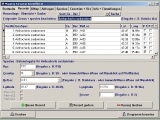
 A Screenshot of the MEB-Programm
A Screenshot of the MEB-Programm
|
| |
Practically all data delivered by recorders were to be fed manually into a database to facilitate computer-aided
evaluation. The manual input of the anticipated huge amount of data is only possible if robust software can be used.
There is no standard software on the market which could meet all the specific requirements of such mass data input.
Therefore, the decision was made to develop a new tailor-made software package. O. KUDRNA contributed the ideas and
requirements for this software, which is called Mapping European Butterflies (MEB).The main requirements for the MEB
software were as follows:
- The software should be clear and easy to use. The complete operation should be possible both with the keyboard and
with the mouse. Inadvertently pressed keys must not result in deletion, change or insertion of records.
- Many of the records differ from each other only in a few items like reference locality or period, the recorder and
country being the same. The software should remember the data of the last inserted record. This data can be entered
automatically in new records as required.
- The search for a species or a certain record (identified by country and/or recorder) must be possible at any time.
- Plotting the distribution maps based upon the records stored is to be done by DMAP - a software package written by
A. MORTON. Thus, the MEB software must export the data in a structure which is supported by DMAP.
- Printing of subsets of records must be possible for any species selected.

 Melanargia arge (I, Latina)
Melanargia arge (I, Latina)
|
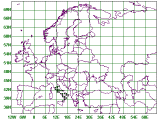
 The Distribution map of Melanargia arge
The Distribution map of Melanargia arge
| |
The MEB software was developed in April 1999 by K. LUX and is being improved continuously. The initial development was
made possible in a very short time with the help of modern software tools: Borland Delphi 3 was the first choice. It is
a graphical software developing environment for Microsoft Windows programs. It was decided to use a common database
Paradox for storing the anticipated more than 100.000 records. Paradox also facilitates import and export of data
from/to other databases such as Microsoft Access or dBase.
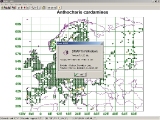
 A Screenshot of the DMap-Program
A Screenshot of the DMap-Program
|
| |
DMAP is a Windows program written by A. MORTON for the production of high-quality distribution maps. It can produce
distribution maps of any area at any scale using a variety of symbol types to display the distributions. In addition to
distribution maps, it can produce frequency maps and coincidence maps which can be used in biodiversity analyses and
studies. The maps can be printed at high resolution in full colour or black and white, and the maps can be exported in
a variety of image formats to other software. Data for DMAP can be entered into a simple text file, a spread-sheet, a
general database, or a biological recording base. The data can consist of latitude/longitude co-ordinates or a variety
of metric co-ordinates such as UTM or national grid references. The projection of the DMAP map is equidistant
cylindrical with the standard parallel at 51°N.
Regrettably, the DMAP version used in this project does not fulfil the following requirements important in the
course of producing the camera-ready copy of the atlas:
- DMAP cannot print two distribution maps on one A4 sheet of paper.
- It cannot position the caption (e.g. the species name) in the place desired.
- The bottom line of (longitude) co-ordinates cannot be deleted if desired.
These drawbacks had to be compensated by time-consuming manual operations: the paper had to be twice passed through
the printer (a few attempts were often necessary to align two maps more or less exactly!), the labels had to be pasted
and the latitude co-ordinates 'erased' by hand.
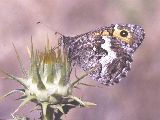
 Hipparchia leighebi (I, Isola Vulcano)
Hipparchia leighebi (I, Isola Vulcano)
|
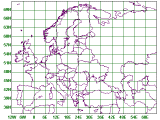
 Distribution map of Hipparchia leighebi
Distribution map of Hipparchia leighebi
| |
|
 Email to Webmaster
Email to Webmaster
 Email to Webmaster
Email to Webmaster